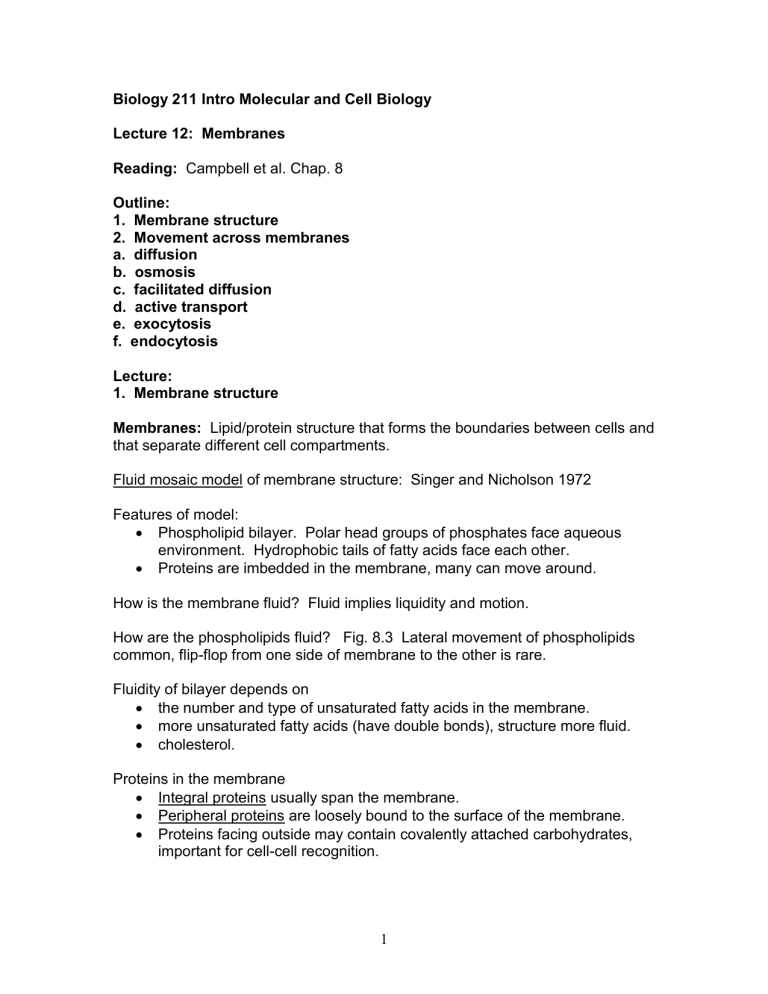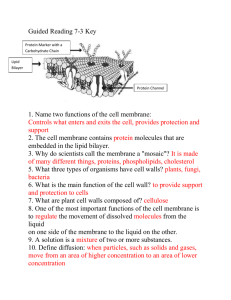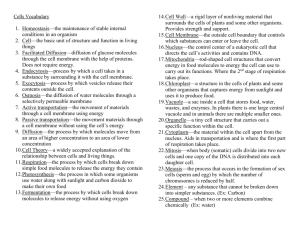Biology 211 Intro Molecular and Cell Biology

Biology 211 Intro Molecular and Cell Biology
Lecture 12: Membranes
Reading: Campbell et al. Chap. 8
Outline:
1. Membrane structure
2. Movement across membranes a. diffusion b. osmosis c. facilitated diffusion d. active transport e. exocytosis f. endocytosis
Lecture:
1. Membrane structure
Membranes: Lipid/protein structure that forms the boundaries between cells and that separate different cell compartments.
Fluid mosaic model of membrane structure: Singer and Nicholson 1972
Features of model:
Phospholipid bilayer. Polar head groups of phosphates face aqueous environment. Hydrophobic tails of fatty acids face each other.
Proteins are imbedded in the membrane, many can move around.
How is the membrane fluid? Fluid implies liquidity and motion.
How are the phospholipids fluid? Fig. 8.3 Lateral movement of phospholipids common, flip-flop from one side of membrane to the other is rare.
Fluidity of bilayer depends on
the number and type of unsaturated fatty acids in the membrane.
more unsaturated fatty acids (have double bonds), structure more fluid.
cholesterol.
Proteins in the membrane
Integral proteins usually span the membrane.
Peripheral proteins are loosely bound to the surface of the membrane.
Proteins facing outside may contain covalently attached carbohydrates, important for cell-cell recognition.
1
2. Movement across membranes
Membranes form a selective barrier. Some molecules enter, some molecules leave. Ease of movement depends on size and chemical properties of the molecule, on internal vs. external concentrations of the molecule, and on particular regulatory proteins and signaling molecules in the membrane.
Many different ways molecules can enter or leave cells: diffusion, osmosis, facilitated diffusion, active transport, exocytosis, endocytosis. a. diffusion: tendency for molecules to spread out into available space.
Molecules move from region of high concentration to region of low concentration.
Diffusion is a spontaneous process; it decreases
G because it increases entropy (randomness).
Examples of substances that move across cell membranes by diffusion: oxygen, carbon dioxide, alcohol. b. osmosis: passive transport of water across a semi-permeable membrane.
Water moves from region of lower solute concentration to region of higher solute concentration.
Demonstration: Dialysis membrane containing solution of high sugar concentration in water solution. Water will move from region of lower solute concentration to region of higher concentration. Therefore water will move into dialysis bag.
Hypotonic: concentration of solute particles lower than within the cell.
Hypertonic: concentration of solute (salt or sugar) particles higher than within the cell. c. facilitated diffusion: movement of polar molecules and ions across membrane with the help of transport proteins.
Fig. 8.13.
Binding of cargo to transport protein induces conformation change that enables movement across membrane. d. active transport: pumping a molecule across a membrane against its concentration gradient. Require a transport protein and an input of energy.
Examples: Na + out of cell, K + into cell.
Fig. 8.15.
2
Energy to power active transport may come from ATP or from membrane potential (voltage generated across membrane).
Example of membrane potential generated by proton pump Fig. 8.16. e. exocytosis: secretion of molecules from cell by fusion of vesicles with the plasma membrane.
Fig. 8.7. Secretory pathway
RER
Golgi apparatus
vesicles
plasma membrane
release to exterior f. endocytosis: the cell takes in macromolecules and particles by forming new vesicles from the plasma membrane.
Fig. 8.18
Three types of endocytosis i) phagocytosis: pseudopodia engulf a particle and package it in a vacuole. ii) pinocytosis: droplets of extracellular fluid are incorporated into the cell in small vesicles. iii) receptor-mediated endocytosis: coated pits form vesicles when specific molecules (ligands) bind to receptors on cell surface. Used for cholesterol uptake.
3








